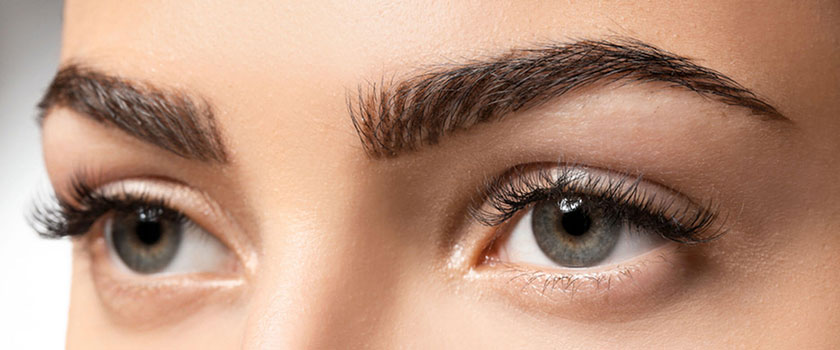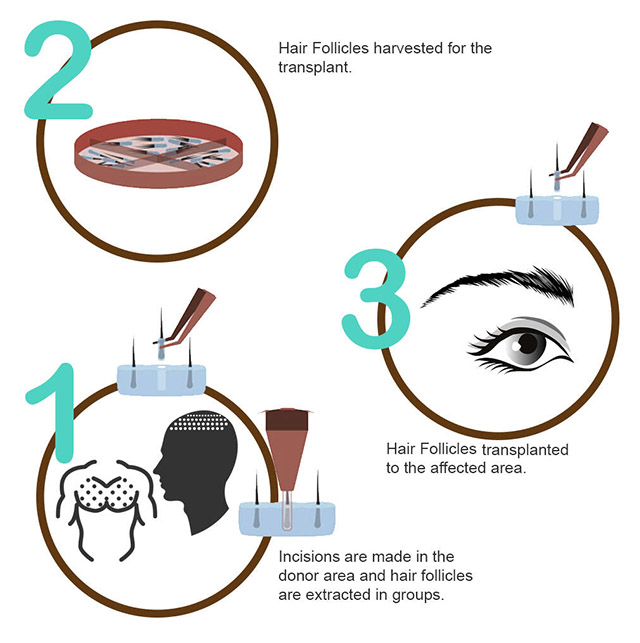What is Eyebrow Transplantation?
To enhance eyebrow density and form, Eyebrow Transplantation involves surgically transplanting hair follicles from the scalp to the eyebrow region. A micro-punch equipment is used to remove hair follicles, which are subsequently transplanted into the eyebrows via tiny incisions under topical anaesthetic. The surgery treats scarring, over-plucking, and thinning eyebrows. The technique usually produces larger, more defined eyebrows after many months.

Why Choose Eyebrow Transplantation in Turkey?
Turkey is a well-known destination for aesthetic procedures, including eyebrow transplantation, thanks to its skilled specialists, affordability, and modern facilities. Here are some reasons to consider Turkey for this procedure:
- Experienced Professionals: Turkey is home to highly trained surgeons who specialize in eyebrow transplantation.
- Cost-effectiveness: Procedures in Turkey are more affordable compared to many other countries, such as the US and Europe.
- Advanced Technology: Many clinics use state-of-the-art techniques, like FUE (Follicular Unit Extraction), which can help achieve a natural look.
- High-quality Facilities: Modern clinics with advanced medical equipment ensure patient safety and comfort.
- Comprehensive Services: Some clinics offer additional services to make your visit convenient, such as assistance with accommodation or transportation.
- Touristic Appeal: While undergoing treatment, patients can also enjoy the rich cultural and scenic attractions that Turkey offers.
As with any medical procedure, it is important to consult a qualified specialist to understand the risks and benefits and ensure the treatment meets your expectations.

What Are the Eyebrow Transplantation Options in Turkey?
Turkey offers several advanced options for eyebrow transplantation, including:
- FUE Eyebrow Transplantation: This widely used method transplants hair follicles from the scalp to the eyebrows using a micro-punch tool. It is minimally invasive and designed to minimize scarring.
- DHI (Direct Hair Implantation) Eyebrow Transplantation: A specialized tool called a Choi pen allows precise implantation of hair follicles, aiming to achieve a natural appearance by controlling the direction, angle, and depth of each hair.
- Synthetic Hair Implantation: This less common technique uses a special needle to implant synthetic eyebrow hairs. However, it may not provide results as natural as other methods.
- Stem Cell Eyebrow Transplantation: A cutting-edge approach that involves the use of stem cells to potentially stimulate eyebrow hair growth. This method is experimental and may not yet be widely available.
As with any medical procedure, there are potential risks and considerations. Consulting a qualified specialist is essential to choose the right method based on your individual hair type, skin characteristics, and overall health.
Who Is a Good Candidate for Eyebrow Transplantation?
Eyebrow transplantation can be an option for individuals experiencing thinning, sparse, or patchy eyebrows, or those who have lost their eyebrows due to accidents or medical conditions such as alopecia. It may also help enhance eyebrow thickness or contour in suitable candidates.
Potential candidates are typically healthy individuals who have realistic expectations about the procedure’s outcomes and sufficient donor hair available on the scalp for transplantation.
However, eyebrow transplantation may not be suitable for everyone. People with bleeding disorders, autoimmune conditions, or those taking medications that could impact healing may need to consider alternative solutions.
It is essential to discuss your medical history, current medications, and expectations with a qualified hair transplant surgeon to determine whether the procedure is appropriate for you.

What Should Be Done Before Eyebrow Transplantation?
Preparing for eyebrow transplantation involves several important steps to ensure the best possible experience and outcomes:
- Consultation with a Hair Transplant Surgeon: A qualified surgeon will assess your needs and recommend the most suitable eyebrow transplantation method. During this consultation, the surgeon will evaluate your eyebrows and scalp, discuss the procedure, outline potential risks, and set realistic expectations.
- Medications: Your surgeon may advise you to avoid certain medications, such as blood thinners or NSAIDs, which could increase the risk of bleeding during and after the procedure. Always consult your doctor before stopping any medications.
- Quit Smoking: Smoking can slow the healing process and increase the risk of complications. It is advisable to stop smoking several weeks before and after the surgery.
- Avoid Alcohol: Refrain from consuming alcohol at least 48 hours prior to the procedure, as it may contribute to increased bleeding.
- Avoid Hair Removal: To preserve hair follicles for transplantation, avoid tweezing, waxing, or threading your eyebrows for at least two weeks before the procedure.
- Plan Transportation: Since local anesthesia will be used, driving yourself home after the procedure is not recommended. Arrange for someone to assist you with transportation.
Following these preparation steps can help improve the likelihood of a smooth and successful procedure. It is essential to consult with your surgeon for personalized advice and to understand the risks and considerations specific to your situation.
How is Eyebrow Transplantation performed?
Eyebrow Transplantation is usually done out-patiently under local anaesthetic. Procedure:
- Donor Hair Extraction: A micro-punch instrument removes hair follicles from the back of the scalp. The hair follicles are harvested in follicular units of one to three hairs.
- Transplant Site Preparation: Local anaesthetic numbs the eyebrow region. The eyebrows are then incised to transplant hair follicles.
- Hair Follicle Implantation: The harvested hair follicles are delicately inserted into the eyebrow’s microscopic incisions. For a natural appearance, the hair follicles are inserted to resemble eyebrow hair development.
- Postoperative Care: Patients will get postoperative care instructions and have their eyebrows wrapped after the treatment. This advice usually includes avoiding intense exercise, keeping the region clean, and avoiding the eyebrow area.
The quantity of hair follicles transplanted determines how long the operation takes. After the treatment, patients may return to work and routine activities, although the transplanted hairs may take weeks to grow. Patients might anticipate complete results from Eyebrow Transplantation after 6–12 months.

Eyebrow Transplantation growth timeline
Age, genetics, and health affect Eyebrow Transplantation growth. Below is a general timeframe for Eyebrow Transplantation patients:
- Following the Procedure: Eyebrow swelling and redness may continue several days. Mild discomfort may be treated with over-the-counter painkillers.
- 2–4 Weeks Following the Procedure: The transplanted hairs will fall out in the first weeks as part of the healing process. Some patients find the “shock loss” period discouraging. Patients shouldn’t worry—the transplanted hairs will come back in a few months.
- 3–4 Months Following the Procedure: Eyebrow hair growth may begin. Nevertheless, the new hairs may be weak and wispy and take many months to grow.
- 6–8 Months Following the Procedure: Patients might anticipate larger, fuller eyebrow hairs by this point. Some individuals may require numerous touch-ups to attain their desired results.
- 12 Months Following the Procedure: Patients should notice their Eyebrow Transplantation outcomes after 12 months. The transplanted eyebrow hairs will have developed and blended in at this point.
How long does Eyebrow Transplantation take in Turkey?
Turkey’s Eyebrow Transplantation operations differ based on the amount of grafts needed, the method employed, and the patient’s demands. Nonetheless, most Eyebrow Transplantation surgeries in Turkey take 2–4 hours to complete.
Hair follicles are removed from the donor region and put into the eyebrows. This includes filling small eyebrow incisions with removed hair follicles. The surgeon will carefully implant each hair follicle to ensure it develops in the appropriate direction and resembles eyebrow hair development.
Patients will be instructed to avoid specific activities and clean the eyebrow region after the operation to facilitate recovery. The transplanted hairs may take several weeks to develop, and patients should expect to see the complete benefits of their Eyebrow Transplantation within 6–12 months.

How long does Eyebrow Transplantation last?
Eyebrow Transplantation is a permanent way to repair eyebrow hair. The transplanted hairs are genetically designed to grow and will not fall out since they are taken from the patient’s scalp.
Nonetheless, the natural ageing process might potentially harm the transplanted eyebrows over time. The transplanted hairs may vary as a person matures due to eyebrow hair structure and colour changes.
Some patients may need touch-ups to preserve their Eyebrow Transplants. If the transplanted hairs don’t mature or the patient wants more eyebrow thickness or density, this may happen.
Eyebrow Transplantation may restore eyebrow hair, but it is vital to moderate expectations and be aware of the possibility of future touch-ups.
How long does Eyebrow Transplantation last?
Eyebrow Transplantation is a permanent way to repair eyebrow hair. The transplanted hairs are genetically designed to grow and will not fall out since they are taken from the patient’s scalp.
Nonetheless, the natural ageing process might potentially harm the transplanted eyebrows over time. The transplanted hairs may vary as a person matures due to eyebrow hair structure and colour changes.
Some patients may need touch-ups to preserve their Eyebrow Transplants. If the transplanted hairs don’t mature or the patient wants more eyebrow thickness or density, this may happen.
Eyebrow Transplantation may restore eyebrow hair, but it is vital to moderate expectations and be aware of the possibility of future touch-ups.
What should be done after Eyebrow Transplantation treatment?
To guarantee normal healing and best outcomes after Eyebrow Transplantation, follow your surgeon’s recommendations. Post-Eyebrow Transplantation guidelines:
- Clean and dry the eyebrows to avoid infection. Your surgeon will provide you cleaning instructions and materials.
- Touching the eyebrow region might harm freshly transplanted hair follicles and impede recovery. Avoid plucking, scratching, or rubbing the eyebrows.
- Avoid vigorous activities: Patients should avoid exercise, hard lifting, and bending for a week following the treatment. These activities may increase eyebrow blood flow, slowing healing.
- Avoid direct sunlight and tanning beds for a month following the operation. Sun exposure may harm freshly transplanted hair follicles and discolour skin, affecting eyebrow look.
- Take recommended medications: Your surgeon may give antibiotics or medicines to prevent infection and control post-op discomfort. Take drugs as prescribed.
- Attend all follow-up meetings with your surgeon to check your progress and promote optimal healing. These consultations may also provide eyebrow-care recommendations from the surgeon.
Following these measures after Eyebrow Transplantation will promote normal recovery and best outcomes.
Who should avoid Eyebrow Transplantation?
Some individuals may not be ideal candidates for Eyebrow Transplantation, even if it’s safe and successful.
Certain drugs and medical conditions may prevent Eyebrow Transplantation. Bleeding, autoimmune, and active infection patients are examples. The operation may also be recommended against patients using blood-thinning or other drugs that alter clotting.
Eyebrow Transplantation requires making tiny skin incisions, which might cause scarring, thus those with keloid scars may not be ideal candidates.
To decide whether Eyebrow Transplantation is right for you, see an expert surgeon. To establish whether you’re a candidate, the surgeon will review your medical history and eyebrow condition.
How many treatment sessions are needed for Eyebrow Transplantation?
Eyebrow Transplantation treatment sessions depend on the patient’s demands and method. Most treatments only require one session.
The surgeon will assess the patient’s eyebrow region to decide how many grafts are required to achieve the desired density and form. The surgeon will also discuss the method, which may alter the number of therapy sessions.
For best results, patients may need a touch-up. If the transplanted hairs do not develop or the patient wants thicker eyebrows, this may be essential.
Most Eyebrow Transplantation patients only require one treatment session, although the number of sessions required depends on the patient’s demands and the method employed.
Alternative treatments for Eyebrow Transplantation
According to the patient’s demands, there are numerous Eyebrow Transplantation alternatives. Alternative therapies include these:
- Microblading: This semi-permanent eyebrow tattooing procedure employs a tiny, portable instrument to generate hair-like strokes in the eyebrow region. This method may be used to fill in sparse regions or define eyebrows.
- Eyebrow extensions: Like eyelash extensions, eyebrow extensions connect individual hairs to the eyebrows to make them larger and more defined. With careful maintenance, extensions consisting of synthetic or real hair may last weeks.
- Eyebrow tinting: This temporary procedure employs a semi-permanent dye to darken eyebrow hairs. This method may be used to fill in sparse eyebrows or improve natural colour.
- Topical eyebrow hair growth products: There are various eyebrow hair growth products on the market. These products include minoxidil or biotin, which are considered to encourage hair growth.
To identify the best treatment choice for your requirements and tastes, visit a trained and experienced specialist.
